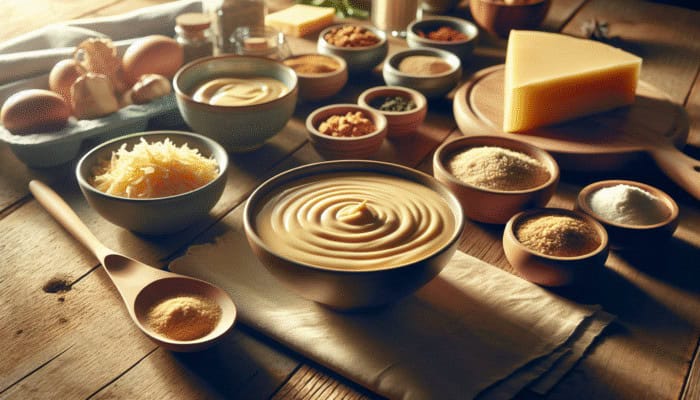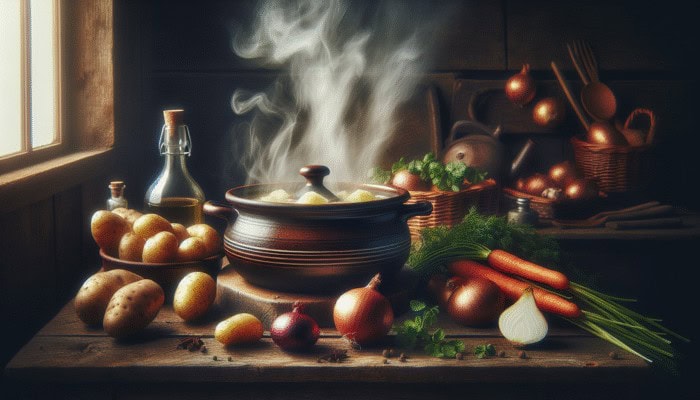Key Ingredients for Crafting a Hearty Casserole
Choosing the Best Seasonal Vegetables for Your Casserole

How to Make a Warm Fall Casserole: Selecting the right vegetables is crucial when mastering the art of creating a comforting autumn casserole. Opt for seasonal choices like squash, sweet potatoes, and root vegetables such as carrots and parsnips. These options not only elevate the flavour profile but also contribute to a robust and hearty texture. Typically, these vegetables reach their peak during the autumn months, providing a wealth of nutrients and natural sweetness that can significantly enhance your dish.
When selecting vegetables, it is essential to consider their respective cooking times. For instance, root vegetables usually require a longer cooking duration compared to softer varieties like zucchini. To achieve a consistent and perfect balance, chop harder vegetables into smaller pieces to ensure they cook evenly alongside the softer ingredients. Visit local farmers' markets or grocery stores to discover fresh selections that inspire your culinary creativity. Opting for organic produce often results in superior flavour and quality, enriching your casserole experience.
Incorporating leafy greens such as spinach or kale towards the end of the cooking process is another fantastic option. These greens not only provide a vibrant burst of colour but also add a wealth of vitamins and minerals that perfectly complement the heartiness of root vegetables. Mixing varying textures—like creamy squash with crunchy carrots or tender greens—creates a delightful mouthfeel that enhances the enjoyment of every bite.
Choosing Protein Sources for Enhanced Nutrition
Integrating a source of protein into your casserole is vital for creating a balanced and satisfying meal. Whether you're preparing for a family gathering or cooking just for yourself, protein options like chicken, beef, or tofu can significantly boost the dish's nutritional value and ensure it is filling. When selecting your protein, consider the dietary preferences and restrictions of your guests to ensure everyone is accommodated.
Shredded chicken is a classic choice that pairs beautifully with vegetables, soaking up the flavours of herbs and spices throughout the cooking process. Alternatively, lean beef can add a rich depth, providing a hearty base that complements the sweetness of root vegetables. If you lean towards a plant-based diet, consider using tofu or tempeh as excellent alternatives. These options absorb flavours effectively and can be marinated or seasoned to elevate their taste.
The type of protein you select can also influence the cooking method of your casserole. For example, browning ground beef or sautéing chicken can create a delicious crust that adds complexity to the dish. Conversely, marinating your tofu and browning it before incorporating it into the casserole can greatly enhance its flavour, giving you the satisfaction of a well-rounded and delicious meal.
Incorporating Essential Spices and Fresh Herbs
Warming spices and fresh herbs can truly transform a comforting autumn casserole into a culinary masterpiece. Spices like cinnamon, nutmeg, and paprika not only add depth to the dish but also evoke the essence of the fall season. A hint of cinnamon can imbue your casserole with warmth, while nutmeg enriches the overall flavour profile with its distinctive sweetness.
Utilising a variety of herbs, such as thyme, rosemary, or sage, can wonderfully complement your selected vegetables and proteins. These aromatic herbs not only enrich the overall flavour of the casserole, making each spoonful a delightful experience, but also add visual appeal. Fresh herbs bring vibrancy that dried herbs may lack, making it advisable to opt for fresh whenever possible.
Experimenting with unique spice blends can also introduce exciting flavour dimensions. A dash of cumin can provide an earthy depth, while a sprinkle of chilli powder can add a subtle heat to your casserole. Achieving balance is essential; combining sweet and savoury spices will result in a harmonious dish that warms the soul. Remember to taste your casserole as you go, adjusting the spices to suit your palate and that of your guests perfectly.
Steps for Preparing Your Casserole

Efficiently Chopping and Prepping Your Ingredients
Effective preparation serves as the backbone of mastering how to create a comforting autumn casserole. Start by carefully chopping and prepping your ingredients to guarantee even cooking throughout the dish. Maintaining uniform cuts is crucial; this practice not only promotes even cooking but also results in a more visually appealing dish.
Begin with your vegetables, as they often require the most preparation time. Peel and chop root vegetables into bite-sized pieces that will cook uniformly. For softer vegetables such as zucchini or bell peppers, larger chunks can help retain their structure during cooking. This approach prevents mushiness and preserves texture, creating a layered experience of flavours and sensations in your casserole.
Once your vegetables are prepared, it's time to focus on your protein. If using chicken or beef, consider marinating beforehand to infuse additional flavours. For tofu or tempeh, pressing them before cooking can help remove excess moisture, allowing them to absorb marinades more effectively. Organising your ingredients into separate bowls can streamline the cooking process and minimise the risk of overlooking any component.
A well-prepped casserole not only cooks more efficiently but also allows for a more enjoyable cooking experience. By dedicating time to prepare your ingredients beforehand, you can concentrate on layering flavours and ensuring that each component shines in the final dish.
Mastering Layering Techniques for Maximum Flavour
Layering ingredients thoughtfully is crucial when learning how to create a comforting autumn casserole. This technique allows for an even distribution of flavours throughout the dish, ensuring that each bite is bursting with deliciousness. Start by layering your casserole dish with the heartiest ingredients at the bottom. For example, commence with a base of root vegetables, followed by your protein, and then add softer vegetables on top.
Consider the cooking times of each ingredient; placing quicker-cooking items higher up in the dish can help prevent them from becoming overly soft and mushy. Additionally, think about the textures you are creating. A layer of creamy mashed potatoes on top can provide a delightful contrast to the crunchy vegetables below, enhancing the overall eating experience.
Don’t overlook the significance of seasoning in each layer. Sprinkling herbs and spices between the ingredients will help meld the flavours beautifully. Start with a light hand; you can always adjust the seasoning as needed during the cooking process. Once your layers are complete, a final sprinkle of cheese or breadcrumbs can create a delectable crust on top that contrasts beautifully with the softer layers beneath.
Mixing and Combining Your Casserole Components

Achieving the desired texture and flavour balance in your casserole requires careful mixing and combining of components. When learning how to create a comforting autumn casserole, consider mixing the wet and dry ingredients separately before combining them. This method facilitates a smoother blending process, ensuring that spices and seasonings are evenly distributed throughout the dish.
For instance, if your casserole includes a creamy sauce, mix the wet ingredients—such as broth, cream, or a plant-based alternative—in one bowl. In another bowl, combine your dry ingredients, which may include spices, breadcrumbs, or cheese. This separation helps create a consistent sauce that adheres evenly to the other components of the casserole.
After mixing your ingredients, gently fold them together to avoid breaking down delicate components, particularly when using cooked proteins. Aim for a cohesive mixture that still showcases the individual items within. The goal is to create a delightful medley of flavours and textures, where each bite offers a burst of satisfying taste.
Selecting the Appropriate Cooking Dish for Your Casserole
The choice of cooking dish can significantly influence the outcome of your casserole. For those exploring how to create a comforting autumn casserole, selecting the right size and type of dish is vital for achieving even cooking and proper browning on top. A glass or ceramic dish retains heat effectively, allowing for consistent cooking and preventing burnt edges while ensuring that your casserole is cooked thoroughly.
It’s essential to select a dish that suits the size of your casserole. An overcrowded dish may lead to uneven cooking, while a dish that is too large can cause the casserole to dry out. Generally, a standard 9×13-inch dish is suitable for most recipes, but feel free to adjust the size according to your specific needs. If you're cooking for a larger group, consider doubling the recipe and using multiple dishes to accommodate everyone.
Once you’ve selected your dish, lightly greasing it can help prevent sticking and make serving easier. Alternatively, lining the bottom with parchment paper can be beneficial, especially if you’re using a sticky mixture. Taking proper care in selecting and preparing your cooking dish will contribute to a beautifully presented casserole that you’ll be proud to serve.
Mastering Timing and Temperature Control for Perfect Casseroles
Achieving the ideal casserole consistency involves careful timing and temperature control throughout the cooking process. When preparing how to create a comforting autumn casserole, preheat your oven to the optimal temperature, which is generally around 180°C. This moderate heat facilitates even cooking, preventing the edges from burning while ensuring the centre is thoroughly heated.
Please keep a close watch on your casserole as it bakes. Cooking times can fluctuate based on the types and quantities of ingredients used. A general guideline is to start checking for doneness around the 30-minute mark. If your casserole has a cheese topping, look for a bubbly, golden crust as a sign that it is ready.
If you notice uneven browning or burning, consider rotating the dish halfway through its cooking time to ensure even cooking. This simple adjustment can help distribute heat more evenly, ensuring a perfectly cooked casserole. Additionally, investing in an oven thermometer can confirm that your oven temperature is accurate, leading to more consistent results every time you prepare your casserole.
Exploring Cooking Methods and Tips
Understanding Oven Temperature and Timing
Baking in the oven is a traditional method when mastering how to create a comforting autumn casserole. A consistent oven temperature, typically around 180°C, is crucial for even cooking and to prevent burning. This moderate heat allows the flavours to meld beautifully while ensuring that all ingredients are evenly cooked throughout.
Before placing your casserole in the oven, ensure it's adequately preheated. A hot oven will initiate the cooking process immediately, promoting even browning and creating a delightful crust on top. It’s also advisable to cover your casserole with foil for the first half of its baking time to retain moisture, then uncover it for the latter portion to achieve that perfect golden, crispy top.
Timing is equally important in the baking process. Depending on the specific ingredients, your casserole may take anywhere from 30 minutes to over an hour to cook thoroughly. Regularly check for doneness by inserting a fork into the centre; if it comes out clean or with tender vegetables, your casserole is ready to be enjoyed. Be prepared to adjust the cooking time according to your specific recipe and the oven's performance.
Utilising a Slow Cooker for Delicious Results
A slow cooker is an excellent tool for creating a comforting autumn casserole, particularly on busy days when you crave comfort food without the fuss. The beauty of a slow cooker lies in its ability to enhance flavours over time. As the ingredients simmer, they meld together, creating a truly harmonious dish.
To utilise a slow cooker effectively, begin by layering your prepared ingredients, starting with heartier vegetables and proteins at the bottom. Add in your seasonings and any liquid components, ensuring even distribution. Set your slow cooker on low for 6-8 hours or high for 3-4 hours, allowing the flavours to develop fully.
One of the key benefits of cooking in a slow cooker is its ability to create tender, rich dishes with minimal supervision. You can prepare your casserole in the morning, set it to cook, and return home to a delicious meal ready to be served. This method is particularly ideal for busy households, allowing for quality family time without sacrificing the enjoyment of home-cooked meals.
Transitioning from Stovetop to Oven for Optimal Flavours
For those seeking a dynamic approach to casserole creation, consider starting on the stovetop before transferring your dish to the oven. This technique proves invaluable when learning how to create a comforting autumn casserole and contributes to a depth of flavour that many methods overlook.
Begin by browning your meat or sautéing your vegetables in a suitable stovetop pan. This initial cooking stage enhances flavours through caramelisation, creating a rich base for your casserole. Once the ingredients are nicely browned, combine them with your remaining components and transfer everything to an oven-safe dish for the finishing touch in the oven.
This stovetop-to-oven transition promotes optimal cooking results, allowing for a beautifully browned top while ensuring that the insides remain moist and flavourful. It’s essential to exercise caution when transferring hot dishes from the stovetop to the oven, utilising oven mittens or heat-resistant gloves to protect your hands from burns.
Exploring Grilling Techniques for Enhanced Flavours
For those looking to add a unique twist to traditional casseroles, grilling can be an exciting method to explore while mastering the art of creating a comforting autumn casserole. The high heat from a grill can impart a charred flavour that enhances both meats and vegetables, offering a delightful contrast to the creamy textures typically associated with casseroles.
Begin by preparing your ingredients as you would for a traditional casserole, ensuring they are seasoned adequately. Preheat your grill to a medium-high temperature and arrange the ingredients on skewers or directly on the grill grates. Grilling vegetables like zucchini, bell peppers, and onions can provide a smoky flavour that beautifully complements your casserole base.
Once grilled to perfection, combine these components with your casserole base and finish cooking in the oven for a tender, flavourful dish that resonates with a summer BBQ vibe, even in the fall. This technique adds versatility to your casserole repertoire and can impress guests with subtle smoky notes that elevate the entire dining experience.
Steaming for Healthier Casserole Options
Steaming is a gentle cooking method that can enhance the nutritional profile of your casserole while preserving moisture. When exploring how to create a comforting autumn casserole, consider incorporating steamed components, especially if your dish includes delicate ingredients like fish or leafy greens.
Steaming retains nutrients and ensures that vibrant colours and textures are preserved. To effectively steam vegetables, use a steaming basket placed over boiling water, allowing the steam to circulate evenly around the ingredients. This method is ideal for vegetables such as broccoli, asparagus, or spinach, which can be added towards the end of your casserole’s baking time to maintain their fresh qualities.
Incorporating steamed ingredients can add a unique texture to your casserole, balancing the richness of heavier components while offering a health-conscious option. The result is a well-rounded dish that boasts both flavour and nutritional value, making it a fantastic addition to your cooking repertoire.
Enhancing the Flavour and Texture of Your Casserole
Creating a Crunchy Topping for Added Texture
The final touch on your casserole can make a substantial difference in both appearance and texture. When learning how to create a comforting autumn casserole, consider adding a crunchy topping to provide a delightful contrast to the soft interior. Options for crunchy toppings are plentiful, ranging from golden breadcrumbs to crispy fried onions or even toasted nuts.
Seasoning breadcrumbs with herbs and spices can significantly enhance their flavour, offering an aromatic crunch that complements the overall dish. A sprinkle of grated Parmesan or a mix of cheeses can elevate the topping further, creating a rich, flavourful crust that beckons to be served.
To achieve the perfect crunch, ensure that your topping is spread evenly over the casserole before placing it in the oven. This will allow it to brown beautifully, creating a textural contrast that is both pleasing to the palate and visually appealing. The satisfying crunch will provide an exciting surprise with each bite, enhancing the overall dining experience.
Incorporating Cheeses for Richness and Flavour
Cheese is a beloved addition that can elevate your casserole to new heights. When exploring how to create a comforting autumn casserole, consider incorporating a variety of cheeses to create layers of flavour and creamy textures. Cheese options like cheddar, mozzarella, or Gruyère melt beautifully, offering richness that complements the heartiness of the dish.
To achieve the best results, add cheese at different stages of the cooking process. Mixing cheese into the casserole base enhances creaminess, while adding it as a topping creates a delightful golden crust. Be mindful of the types of cheese you choose; aged cheeses typically provide bolder flavours, while milder varieties can contribute a gentle creaminess.
Incorporating cheese also allows for creative exploration. Consider adding a touch of blue cheese for a bold kick or feta for a tangy contrast that pairs well with roasted vegetables. The diversity of cheese options ensures that each casserole can be uniquely crafted to suit individual preferences, making it a versatile ingredient in your cooking arsenal.
Balancing Sweet and Savoury Flavours in Your Casserole
Striking the right balance between sweet and savoury elements is crucial when mastering how to create a comforting autumn casserole. Consider integrating ingredients like apples, pears, or even dried fruits such as cranberries or raisins to provide a natural sweetness that beautifully contrasts with savoury components. This balance creates a more complex flavour profile that keeps diners engaged and guessing with each bite.
When incorporating sweet ingredients, consider the cooking time and how they will interact with other components. For instance, adding diced apples or pears can introduce a pleasant fruitiness that complements roasted vegetables or meats wonderfully. Conversely, adding a drizzle of honey or maple syrup into your sauce can enhance the overall flavour without overpowering the savoury base.
The interplay of sweet and savoury elements enhances flavour while also improving the visual appeal of your casserole. Layering vibrant, colourful ingredients creates a dish that is not only delicious but also inviting and appetising. This strategic balance can elevate your casserole from ordinary to extraordinary, ensuring it becomes a favourite in your culinary repertoire.
Serving and Presenting Your Casserole
Garnishing Your Casserole for Visual Appeal
Presentation plays a crucial role when serving your casserole, particularly as you explore how to create a comforting autumn casserole. A well-garnished dish not only looks inviting but also elevates the overall dining experience. Fresh herbs, such as parsley or chives, can add a pop of colour and a fresh aroma that enhances the visual appeal of your casserole.
Consider drizzling a touch of olive oil or balsamic glaze over the top for an added touch of elegance. This simple addition can elevate the presentation, making it look more gourmet. Additionally, a sprinkle of paprika or crushed red pepper can introduce a vibrant contrast that entices the eye while hinting at the flavours within.
When plating your casserole, opt for attractive serving dishes that showcase the layers and colours of your ingredients. A shallow, wide dish can make serving easier while allowing everyone to appreciate the beautiful presentation. Remember, the first impression is often the most impactful; ensuring your casserole is visually stunning will heighten anticipation and enjoyment at the dining table.
Complementing Your Casserole with Side Dishes
A hearty casserole is most enjoyable when complemented by thoughtfully selected side dishes. When creating a comforting autumn casserole, consider serving it alongside a fresh green salad or a light vegetable side. Crisp, fresh vegetables can provide a refreshing contrast to the richness of the casserole, balancing out the meal and adding a variety of textures.
A light vinaigrette can enhance the flavours of the salad, while roasted seasonal vegetables can echo the flavours of the casserole itself. Options like a simple green salad topped with cranberries or walnuts, or roasted Brussels sprouts dressed in balsamic glaze, can harmonise beautifully with the flavours of your main dish.
Pairing your casserole with the right side dishes not only enriches the meal but also opens up opportunities for creativity and variety. Consider seasonal ingredients and flavours that complement your casserole, creating a harmonious dining experience that satisfies everyone.
Portioning for Varied Serving Sizes
Understanding how to portion your casserole is essential for both entertaining and casual dinners. When creating a comforting autumn casserole, adjust portion sizes to cater to individual appetites or serve at gatherings. A well-portioned casserole ensures that everyone receives an adequate serving while minimising waste.
For smaller gatherings, consider making individual portions using ramekins or smaller baking dishes. This approach not only enhances presentation but also allows for personalisation in terms of seasoning and toppings. Alternatively, if hosting a larger event, ensure your casserole is cut into equal portions, making it easier for guests to serve themselves while preserving the dish's structure.
Be mindful of dietary considerations when serving. Offering additional sides or salad options can accommodate various dietary preferences, ensuring that everyone enjoys the meal. Thoughtful portioning also facilitates leftovers, making it easy to store and reheat for future enjoyment.
Mastering Plating Techniques for Your Casserole
The art of plating can elevate your casserole from a simple home-cooked meal to a stunning culinary experience. When learning how to create a comforting autumn casserole, consider how you arrange the dish on the plate to achieve a visually appealing presentation. Start by using a large spoon or spatula to serve a generous portion onto the plate, allowing the layers to be visible and inviting.
Incorporate garnishes, such as fresh herbs or a drizzle of sauce, to enhance the visual appeal. A well-placed sprig of thyme or a few shavings of cheese can create an inviting look that encourages diners to dig in. Remember to leave space on the plate for any accompanying side dishes, ensuring a balanced and inviting presentation.
Taking the time to plate your casserole thoughtfully can enhance the dining experience, improving not only the taste but also the enjoyment of the meal. A beautifully presented dish reflects your care and attention, making it a memorable occasion for everyone gathered around the table.
Ensuring the Right Temperature and Timing for Serving
Serving your casserole at the appropriate temperature is crucial for ensuring the best taste and texture. When mastering how to create a comforting autumn casserole, timing your serving so that the dish is piping hot will enhance the flavours and provide a comforting experience for everyone at the table.
Once your casserole is out of the oven, allow it to sit for a few minutes before serving. This resting period allows the flavours to settle while ensuring that the casserole maintains its structure when being served. However, be cautious not to wait too long; timing is key to maintaining the warmth and inviting aroma that makes casseroles so appealing.
If preparing for guests, consider using warming trays to keep your casserole hot while serving. This approach ensures that everyone enjoys their meal at an optimal temperature, enhancing both flavour and comfort. The satisfying warmth of a freshly made casserole can create a sense of togetherness and enjoyment that resonates long after the meal has ended.
Storing and Reheating Your Casserole
Implementing Proper Storage Techniques
Storing your casserole correctly is vital for preserving its flavour and ensuring food safety. When creating a comforting autumn casserole, allow it to cool completely before refrigerating or freezing. This practice prevents condensation from forming, which can lead to sogginess and a loss of texture.
Utilise airtight containers or wrap your casserole tightly with plastic wrap or aluminium foil to maintain its freshness. For long-term storage, consider portioning your casserole into individual servings, making it easy to reheat later. Labelling containers with dates can help you keep track of freshness, ensuring that you consume leftovers within their optimal timeframe.
If freezing, it’s best to consume your casserole within three to four months for the best quality. Ensure that it is well-wrapped to prevent freezer burn, which can diminish taste and texture. Proper storage techniques can keep your casserole delicious and ready to enjoy whenever the craving strikes.
Reheating Without Compromising Quality
Reheating your casserole properly is just as important as the initial cooking process. When exploring how to create a comforting autumn casserole, consider using either the oven or microwave for reheating, depending on your time constraints. While the microwave offers speed, the oven can deliver superior results in terms of texture and flavour.
When using the oven, preheat it to around 180°C and place the casserole in a covered dish to retain moisture. Reheating times may vary, so check periodically to ensure the food is warm. If reheating individual portions in the microwave, add a splash of broth or water to maintain moisture and prevent dryness.
Regardless of your method, the goal is to ensure the casserole is heated through without losing its original quality. Taking these steps will allow you to enjoy your delicious leftovers just as much as when they were initially made.
Freezing for Future Enjoyment
Freezing your casserole is an excellent way to ensure you have a comforting meal ready whenever you need it. When learning how to create a comforting autumn casserole, consider portioning it into freezer-safe containers for easy reheating later on. This method not only saves time but also helps reduce food waste.
Before freezing, ensure your casserole has cooled completely to prevent ice crystals from forming. Wrapping it tightly in plastic wrap followed by foil can help protect it from freezer burn, preserving both flavour and texture. Clearly label each container with the date and contents, making it easy to identify meals in the future.
When you’re ready to enjoy a frozen casserole, transfer it to the fridge to thaw overnight. For quicker results, you can reheat it straight from the freezer, adjusting cooking time accordingly. This meal prep strategy allows for a diverse array of warming casseroles at your fingertips, ready to satisfy cravings in no time.
Safely Using Leftovers from Your Casserole
Leftovers provide a delightful opportunity to experience your casserole anew, but safety is paramount. When exploring how to create a comforting autumn casserole, it’s essential to consume leftovers within three to four days if refrigerated. If you’ve frozen your casserole, aim to eat it within three to four months for optimal freshness and safety.
Always ensure that leftovers are stored in airtight containers to maintain quality and prevent contamination. When reheating, check that the internal temperature reaches at least 75°C to eliminate any potential foodborne bacteria. Proper handling and storage of leftovers can ensure that the comfort of your casserole can be relished more than once.
Frequently Asked Questions
What are the top vegetables to use in a fall casserole?
Seasonal vegetables like squash, sweet potatoes, root vegetables, and leafy greens work wonderfully in fall casseroles, adding both flavour and nutrition to the dish.
Is it possible to prepare a casserole in advance?
Casseroles can be prepped ahead of time and stored in the fridge or freezer. Reheat when you're ready to serve, making entertaining or busy nights much easier.
How can I prevent my casserole from drying out during baking?
Covering your casserole with foil while baking and adding liquids like broth or cream can help maintain moisture and prevent drying out, ensuring a delicious result.
What is the most effective method for reheating leftovers?
Reheat leftovers in the oven for the best texture. Cover with foil and heat at 180°C until warmed through, or use a microwave with a splash of liquid to maintain moisture and flavour.
Can I freeze a baked casserole?
Yes, baked casseroles can be frozen. Allow them to cool, then wrap them tightly and store them in freezer-safe containers. Consume within three to four months for optimal quality and taste.
Which types of cheese are best suited for casseroles?
Cheeses like cheddar, mozzarella, and Gruyère melt beautifully, adding richness to your dish. Feel free to experiment with different cheeses to create varied flavours and textures.
How can I add a crunchy element to my casserole?
Add a crunchy topping of breadcrumbs, nuts, or crispy onions before baking for a delightful texture and flavour contrast that enhances the overall dish.
Is it possible to use gluten-free ingredients in casseroles?
Absolutely! Substitute regular pasta or breadcrumbs with gluten-free options to accommodate dietary restrictions while still enjoying a hearty casserole.
What protein options work best for casseroles?
Chicken, beef, tofu, and tempeh are all excellent sources of protein. Select according to your preference and dietary needs for a well-rounded and satisfying dish.
How long does it typically take to bake a casserole?
Baking times vary, but most casseroles cook at approximately 180°C for 30 minutes to an hour. Check for doneness by inserting a fork into the centre; if it comes out clean, your casserole is ready.



I love the emphasis on seasonal vegetables! It’s amazing how they can transform a simple casserole into something truly comforting. I’ve been experimenting with adding roasted butternut squash and beets to mine lately. It not only adds a beautiful color but also a complex sweetness that really stands out.
It’s really great to hear you’re enjoying seasonal vegetables in your casseroles. Roasted butternut squash and beets are such a fantastic addition. The way they create that warm, inviting color is hard to beat, and the sweetness can balance out savory flavors so nicely.
I’m glad to hear you’re enjoying seasonal vegetables! If you’re looking for more inspiration to elevate your casseroles, check out some of our favorite recipes featuring vibrant veggies like butternut squash and beets.
https://cookinggods.com/KetoBreads
Selecting seasonal vegetables not only enhances the flavor of a casserole but also fosters a deeper connection to the changing seasons and local agriculture. I remember a particularly memorable autumn dinner where I used a mix of butternut squash, carrots, and turnips from a nearby farmer’s market. The sweetness of the squash paired beautifully with the earthy notes of the turnips, creating a dish that truly felt like a warm hug on a chilly evening.